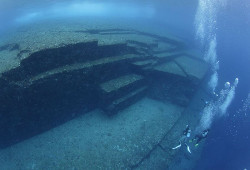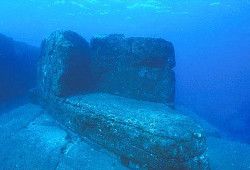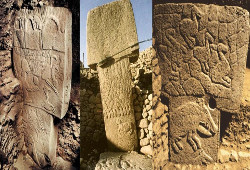Yonaguni Monument, Japan.
Located off the coast of Yonaguni, the southernmost of the Ryukyu Islands this submerged rock formation was discovered by a diver in 1986. The strange formation is about 25 metres below sea level with massive rectangular formations with perfect 90 degree angles, straight walls, steps, columns and something that appears to be a human face carved in the rock. Many objects were discovered both on land and in the sea around the structures including sculptures made of stone that resemble animal figures.
The enormous stone monument is made of sandstone and consists of a flat platform covered with ornaments, nearly perfectly flat steps and terraces of different shapes. Masaaki Kimura, a marine geologist believes that the site is over five thousand years old and may have sunk during an earthquake. What is interesting is that this monument appears to be connected by roads and water lines to other structures found on Yonaguni, a castle, five temple-like structures and something that seems to be like a stadium.


Göbekli Tepe, Turkey.
This megalith is situated on a flat and barren plateau and has been categorised as a site of the Pre-Pottery Neolithic A Period (c. 9600–7300 BC). Göbekli Tepe is said to predate Stonehenge by some 6,000 years) and it was first noted in a survey conducted in 1963 by Istanbul University and the University of Chicago. Excavations began in 1995 by Prof. Klaus Schmidt with the help of the German Archaeological Institute.
The megalith is a series of mainly circular and oval-shaped structures set on the top of a hill. The structures are massive carved stones, crafted and arranged by prehistoric people who had not yet developed metal tools or even pottery. Prof. Klaus Schmidt believes that it is the site of the world's oldest temple and it is regarded as an archaeological discovery of great importance since it could change the understanding of a crucial stage in the development of human society.


Giant Stone Spheres, Costa Rica.
One of the strangest mysteries in archaeology that was discovered in the Diquis Delta of Costa Rica. These stone balls range in size from a few centimetres to over 2 metres in diameter. Since the 1930s to today around 300 balls have been found. They are made of granodiorite, a hard to carve, igneous stone found in the nearby Talamanca range. Numerous myths surround the stones and the population said to have built them.
The rocks are thought to have been build between 1000 and 500 B.C. though actual dating is difficult as the native population that build them has vanished. Different theories state that they may have come from Atlantis, or that they were made as such by nature and some local legends state that the native inhabitants had access to a potion that could soften the rock.
What exactly were they used for? Nobody knows for sure and while the rocks have been affected, broken and worn over thousands of years, it is believed that they were initially designed as perfect spheres.


The Unfinished Obelisk, Egypt.
Officially protected by the Egyptian government as an archaeological site the unfinished obelisk is one of the most famous stones left behind. Taller than any known obelisk ever raised, the unfinished obelisk is the largest known ancient obelisk. It is located in the northern region of the stone quarries of ancient Egypt in Aswan (Assuan).
It is thought that it was abandoned during its construction when some cracks appeared in the rock. And some believe the female pharaoh known as Hatshepsut sanctioned its construction. If finished, the unfinished obelisk would have measured around 42 metres and would have weighed nearly 1,200 tons. Another unfinished partly worked on obelisk base was discovered in the quarries in 2005.


Dwarka Mythical City, India.
Until recently believed to be merely a legend, the mythical city of Dwarka was, according to Hindu texts, the dwelling place of the deity known as Krishna and it is thought to have existed at least 9,000 years ago. The city is about 8 km long, about 3 km wide and it is located approximately 35 metres underwater in the Gulf of Cambay.
According to ancient Hindu texts, the city was also a skirmish ground for lord Krishna and king Salva. As it is described Dwarka was attacked by King Salva with a flying machine and attacked with what resembled a discharge of lightning so devastating that it left the city in ruins. Lord Krishna himself counterattacked with what looked like arrows that roared like a thunder and shone like rays of the Sun.

